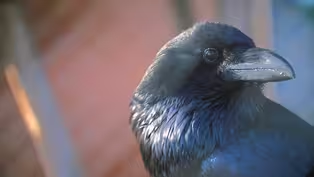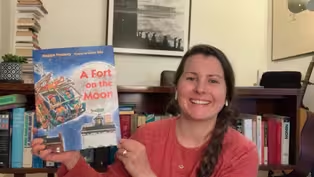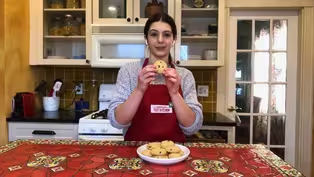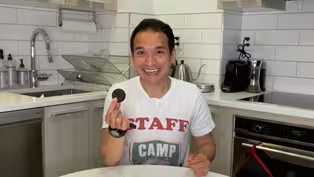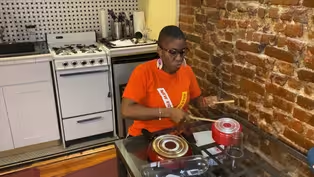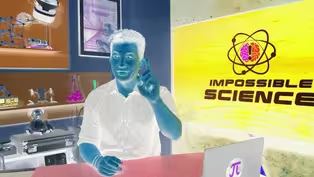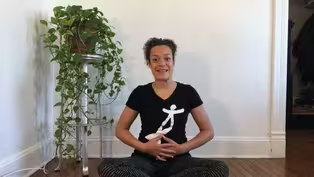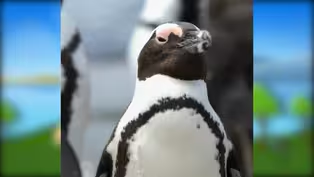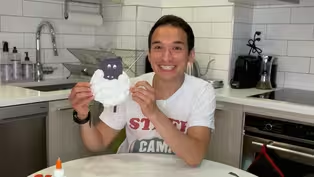
Black and White Day (Long Version)
7/12/2021 | 56m 46sVideo has Closed Captions
Meet penguins and ravens, turn black & white video into color, sketch the moon!
Join head counselor Zach to meet penguins and ravens, turn black & white video into color, sketch the moon! Make chewy chocolate chip cookies, dance to go-go rhythms, make a sheep, sing about a shooting star. Content partners include America’s Test Kitchen Kids, Guggenheim Museum, Impossible Science, National Dance Institute, New Victory Theater, Memphis Zoo, They Might Be Giants.
Problems playing video? | Closed Captioning Feedback
Problems playing video? | Closed Captioning Feedback
Camp TV is a local public television program presented by THIRTEEN PBS

Black and White Day (Long Version)
7/12/2021 | 56m 46sVideo has Closed Captions
Join head counselor Zach to meet penguins and ravens, turn black & white video into color, sketch the moon! Make chewy chocolate chip cookies, dance to go-go rhythms, make a sheep, sing about a shooting star. Content partners include America’s Test Kitchen Kids, Guggenheim Museum, Impossible Science, National Dance Institute, New Victory Theater, Memphis Zoo, They Might Be Giants.
Problems playing video? | Closed Captioning Feedback
How to Watch Camp TV
Camp TV is available to stream on pbs.org and the free PBS App, available on iPhone, Apple TV, Android TV, Android smartphones, Amazon Fire TV, Amazon Fire Tablet, Roku, Samsung Smart TV, and Vizio.
Providing Support for PBS.org
Learn Moreabout PBS online sponsorship- Hi everybody!
My name is Zack and welcome to "Camp TV".
Are you ready for some summer fun?
Me too!
Now, as your head counselor, I will be introducing you to all sorts of cool activities.
Arts, crafts, games, math, and science.
As well as some of my favorite books, nature, and theater.
I will be here to take you from one activity to the next.
So follow me on "Camp TV".
[upbeat music] - [Announcer] This program was made possible in part by the Corporation for Public Broadcasting, a private corporation funded by the American people.
Additional funding was provided by The Peter G. Peterson and Joan Ganz Cooney Fund, and the Pine Tree Foundation of New York.
[ukulele playing] ♪ Camp TV ♪ ♪ It's time for us to start ♪ ♪ From furry animal encounters ♪ ♪ To summer reading and the arts ♪ ♪ No matter what the weather ♪ ♪ We'll explore it all together ♪ ♪ It's a place for you me ♪ ♪ It's "Camp TV" ♪ [whimsical music] [door bell ringing] [whimsical music] [penguin gaking] - Well don't you look magnificent.
Thank you for accepting my invitation.
Do come in.
[footsteps clacking] [door clicking shut] [bell ringing] [penguin gaking] Might I start you off with something cool to drink?
Or perhaps a black and white cookie?
[doorbell ringing] Would you excuse me for a moment?
[penguin gaking] [cow mooing] Oh!
My goodness!
You gave me quite a fright.
No worries, it's good to see you again.
Do come in.
[bell clanging] [footsteps stomping] [cow mooing] The bathroom?
Of course.
First door on the left.
[bell clanging] [footsteps stomping] A gift for me?
How thoughtful of you, Mr. Penguin.
You shouldn't have.
Shall I open it now?
[penguin gaking] All righty, then.
A black and white soccer ball!
How very appropriate.
Perhaps a little game later?
[penguin gaking] [sniffing] Do you smell that?
[penguin gaking] Whoo.
Pardon me for a moment.
Yep, must be him.
[deep breath] Mr.
Skunk, welcome.
We've been expecting you.
[footsteps scuffling] [deep breath] [whimsical music] [door clicking shut] [bell ringing] [guests conversing in silly, muffled sounds] [piano playing] If I can have your attention, please?
[guest clapping] To all my wonderful guests, I can't thank you enough for attending.
Don't you look fantastic.
All decked out in black and white.
It gives me great pleasure to officially welcome you, and you, to Black and White Day on "Camp TV".
Now, normally I wouldn't stand on a ceremony, but today I insist.
[cow mooing] Now, as I was saying.
Normally I wouldn't stand on ceremony, [cow mooing] [door thumping] Oh, no!
Sounds like Mr. Cow might of locked himself in the bathroom by accident.
[snapping finger] Gotta get that door checked.
[gasping] Be right there, Mr. Cow!
[cow mooing] I'll take care of this.
Why don't you head out to your first few activities?
Coming!
[lively music] - [Zack] A little birdie told me, it's time to go wild.
- Hi friends!
My name is Chelsea.
And I'm an animal interpreter here at the Memphis Zoo.
Today, we're joined by our partners at Avian Behavior International.
And they are sharing with us their bird, Forrest, the White-Necked Raven.
Now behind me, Forrest is going to be moving in, out, and around the stage with his trainer doing some natural behaviors.
Now have you even seen a raven or a crow outside?
Well, ravens actually aren't so different from us.
They're very social, highly-intelligent, and play an important role in their eco-system.
And there are things that we can do to make sure they stay healthy in the wild.
Let's find out how.
While White-Neck Ravens like Forrest are native to the southeastern coast of Africa, ravens and their cousins can be found almost everywhere in the world, just like humans.
Ravens are often found in pairs or small family groups.
But they also like to spend time in big groups.
Are you close with your family?
Do you have a trusted friend?
Ravens, just like us, enjoy spending time with those that they know.
They also take their time leaving home.
Some ravens will spread their wings and find a new home after a few months with their parents.
While others will stay for years.
Having a balanced diet is important for a raven's health.
Do you eat just one thing?
Or do you prefer to have something different for every meal?
Ravens will eat anything from fruit to vegetables, and bugs to mice.
They're what we call omnivores, because they ohm, num, num on plants and meat.
And we're omnivores, too, by nature.
What sets ravens apart from other animals is their intelligence.
Social animals think more about their actions in order to get along with one another.
This means that ravens aren't so dissimilar to us in the brain department.
Researchers in California that were checking on the nests of endangered shore birds, noticed that the native ravens would wait for the researchers to find a nest, and once they left, the ravens would take advantage and eat the egg.
They got the researchers to do the food finding for them.
By putting the eggs in a stump, Forrest also displays his cashing behavior.
Cashing is what ravens do when they want to save some leftovers for later.
They hide it, and then remember to come back for it.
Forrest is pretty amazing, isn't he?
Now in the past, you might of found ravens in open plains or out in forests, but with increasing human development, these ravens with their intelligence and adaptability have had to learn how to live around humans in an urban environment, like cities.
Despite this, there are limits to the flexibility of the raven, and they need you to help them stick around.
Like we talked about, ravens eat a wide variety of foods, which means they're important in their home.
By eating bugs, mice, and even dead things, they make sure their home is clean and disease-free.
They also enjoy fruits and seeds, which means they're seed dispersers.
Seed dispersers eat fruit or seeds, and then poop them back out.
Because the seeds are in that nice fertilizer packet, a new plant can grow easily.
Without ravens, a lot of plants would go uneaten, and therefore, unplanted.
In order to keep doing their job, ravens will need a helping hand, and wing, from humans, including you.
The simplest way to help ravens and other wildlife is to tell people about them.
Share what you learned today with your friends and family.
The more people that know how awesome ravens are, the better!
You can also go out on nature walks.
While you might not see a raven, you'll see lots of other cool animals, no matter where you live.
Make sure to respect nature by appreciating it from a ar, though.
This means not picking up rocks, kicking over logs, or touching animals.
That way, both you and the animals can be happy and safe.
By just spending time with Forrest today, you've also helped ravens.
Learning more about wildlife is a great way to know how to help them.
With a trusted adult, go to the library, or use a computer to learn more about ravens and other animals in your area.
You might be surprised by who your animal neighbors are.
Today we talked all things raven.
Forrest taught us about the lives of White-Necked Ravens, and how clever they can be.
We also learned about seemingly-common animals.
And how we can help them and other wildlife through the actions that we take.
Remember, ordinary animals can become extraordinary with a closer look.
Now on behalf of myself, Avian Behavior International, and the rest of us here at the Memphis Zoo, thank you so much for hanging out with us.
See you later!
[lively music] - [Zack] It's time to get active.
Let's move!
- Hi, my name Calia Marshall, and I'm a teaching artist with National Dance Institute.
Today, we're gonna explore the incredible complex system of our bodies.
We have bones, muscles, tendons, ligaments, organs, and so much more.
The music that you'll hear today is by NDI musician, Todd Keller.
[soft guitar music begins playing] Thanks, Todd.
All right, let's get exploring.
We're gonna start with the most structural parts of our bodies, our bones.
The places were bones meet are called joints.
There are lots of different types of joints in our body.
We're gonna talk about three.
The first is a hinged joint.
Start to bend your elbows.
See how your arms can move in this direction?
But then, see if you can try to move your arm out and in, at this joint.
It doesn't really work so much, right?
Same thing happens in your knees.
Start bending your knees.
This works really well, right?
But can you move your knee in and out?
Not so much.
So that's a hinged joint.
Now start to circle your arms.
Yeah, so this is called a ball and socket joint.
It creates a lot of range of motion, right?
'Cause your shoulder has a socket.
And at the top of this bone, there's a ball that fits in.
And it creates lots of range.
You have the same in your hips.
Try to move your leg to see how much more movement there is in this joint, than there was at your knees, right?
The third we'll talk about is a pivot joint.
That's when there is a center point, and another ball rotates around that.
You have a pivot joint in your neck, between the first and second vertebra.
And it allows you to look from side to side.
Try that out.
Great.
There's also one in your forearm.
There are two bones here, the ulna and the radius.
And the radius rotates over the ulna.
Try holding onto your elbow and see if you can turn, and see that bone starting to rotate and twist over the other bone.
Pretty cool, right?
None of that movement in our joints would be possible if it weren't for our muscles.
Our muscles help us move through space by contracting and releasing.
Try contracting your muscles.
Squeeze, squeeze, squeeze, squeeze, squeeze, and rest.
And squeeze, squeeze, squeeze, squeeze, squeeze, and release.
Good.
So our muscles grow strong because of gravity.
The force that pulls us toward the center of the earth.
Try moving away from gravity.
[body thumping] Gravity keeps pulling us back.
Well, do you notice though, that in water, it's possible to float.
Mm.
That's because there's less gravitation pull in water.
Come on down, let's try something.
Imagine you're a baby inside a watery womb.
Because gravitational pull is less here, you can slowly float around.
But when you're born, gravity is stronger.
It takes time to develop the muscles you need in order to hold yourself up.
The more you push away from gravity, the stronger you become.
And then finally, [big exhale] you can hold yourself up.
Another essential function of our bodies is our breath.
Let's take a deep breath in.
[deep inhale] and a long breath out.
[deep exhale] Now take your hands to your belly.
Imagine your belly's a balloon, and inflate your balloon as you breathe in.
Deflate as you breathe out.
Great.
Now underneath your rib cage sits your diaphragm muscle.
It's kind of shaped like a parachute.
As you breathe in and your lungs expand, the diaphragm muscle presses down, which makes your belly expand.
And as you breathe out, the muscle softens back underneath your rib cage.
Take two deep breaths and see if you can feel your diaphragm muscle.
[deep breathing] [soft guitar music continues] One more.
[deep breathing] [soft guitar music continues] Now let's use our joints, our muscles, and our breath to create a dance.
Come down, we're gonna curl up into fetal position to start.
We're gonna take 16 counts to move against gravity and come all the way up to stand.
Ready, steady, here we go.
One, two, three, four, five, six, seven, eight, nine, 10, 11, 12, 13, 14, 15, 16.
Then we'll explore our pivot joints.
One, two, three, four, five, six, seven, eight.
Our hinge joints.
One, two, three, four, five, six, seven, eight.
Then our ball and socket joints.
One, two, three, four, five, six, seven, eight.
And then all of your joints at the same time!
One, two, three, four, five, six, seven, eight.
Great!
After that, we'll finish with some deep breaths.
So breathe in for two, out for two, in for two, out for two.
Take a deep breath in, and long breath out.
Yes, let's put that whole thing together two times in a row, with Todd.
Here we go, up.
[guitar music begins] Pivot, joint.
Hand joint.
Ball and socket.
All the joints.
Breathe in, an out.
In, and out.
Breathe in, and exhale out.
Try it again.
[gasping] Pivot joint.
Hand joint.
Ball and socket.
All the joints.
And now breathe in, and out, in, and out.
Then back.
Thank you for joining me for this body exploration.
I hope you learned something new.
Have a great day.
Bye!
- Welcome back to Black and White Day on "Camp TV".
I do hope you had a brilliant time at your last activity.
Mr. Penguin and I were just about to have some lovely afternoon tea.
Would you care to join us?
Splendid.
Now, remember all, pinky's in.
[slurping] Ah!
[gasping] Oh dear!
I forgot the napkins.
Apologies, Mr. Penguin.
I will be right back.
[whimsical music] Oh, double dear.
It seems I'm out of napkins.
Which, actually isn't so bad, because paper napkins aren't so great for the environment.
Ah!
But I do have cloth napkins.
Even better.
Well, but, I can't give Mr. Penguin just any old napkin.
He has very high standards.
Hm?
What can I do to make it extra-special?
Extra-fancy, extra black tie-ish?
Hm?
I believe I have just the trick.
Looking for a way to make any ho-hum napkin instantly more elegant?
Try this.
A dinner jacket napkin.
Take your napkin and fold it in a triangle.
On the long side of the triangle, fold over the middle of the napkin to create a collar.
Like this.
Use your hands to smooth it out, creating a crease.
Flip the napkin over.
Put your fingers here, and fold one corner in, then the other corner in.
Can you see the beginnings of the dinner jacket forming?
Carefully hold everything in place as you flip the napkin over.
Fold one corner in, and the other corner in.
Take the bottom section, fold it up, and flip it over one last time.
Place a bow tie in the middle, and walla!
Instant elegance.
[whimsical music] Monsieur?
Your napkin.
[penguin gaking] Now if I could only get him to use it.
See you after your next few activities.
Curiosity and wonder.
Let's discover together.
It's Science Wow!
- Don't adjust your screens.
We're doing an optical illusion where if it works, you're gonna see color on your side of the screen, even though your looking at a black and white video.
Now right now you're looking at a negative image.
So I need you to keep focusing right here.
And in a matter of moments, I'm about to switch this to a black and white video.
And yet, momentarily, you'll still see color like right now.
Pretty crazy, right?
Welcome to "Impossible Science."
[musical explosion] Today we're going to transform a black and white image into one full of color.
Now sounds impossible.
In fact, this has been an idea for magic tricks for countless years.
If we try to find ways to make color appear at our finger tips.
And whether it's done with a deck of cards, or a magic coloring book, it doesn't matter.
Because there's a real secret to making color appear.
It turns out this one is possible through science.
If you wanna trick the eye, we should know how it works.
If we take a closer look at the back of the eye, there's a thin tissue know as the retina.
Now the the retina is comprised of two different types of photoreceptor cells.
There are rods, and there's cones.
The rods are responsible for detecting different levels of light.
They're also responsible for our vision at nighttime.
While the cones, they're responsible for detecting the colors.
The reds, the greens, and blues in different combinations.
Both the rods and the cones work together to send signals down the optical nerve and up to the brain.
Where the brain deciphers those signals to see what we're looking at.
Now that we understand the pipeline, well, let's figure out how we can trick it.
Okay, we're gonna trick the eye by using what's called After Image.
An After Image is what happens when you engage the same photoreceptors, the back of the eye for an extended period of time.
Roughly 20 or 30 seconds.
You know, what you don't notice throughout the day is that your photoreceptors in your eye are constantly being adjusted.
See, you're constantly focusing in on different things.
You're looking at different bright lights and different color shades, and those photoreceptors are adjusting.
Now don't think there's only like a few of these things.
There's about 90 to 120 million rods in your eye, and there's roughly six or seven million cones in your eye.
So you can see, there already be a lot of different adjustments going on throughout the day.
But what we wanna do is tire the same photoreceptors out for an extended period of time.
So, let's do the experiment again, and I'll walk you through what's happening.
So here we go.
I need you to focus right here.
And I'm gonna stay as still as possible.
And as I explain what's happening, so that I can engage the same photoreceptors.
What's happening right now, is the photoreceptors in your eyes, the ones that are seeing the bright lights are telling the brain that it's seeing bright lights, bright colors.
While there's other photoreceptors that are detecting the darker shades and the darker colors.
Now they're not working as hard as the ones that are detecting the bright lights.
The ones that are detecting the bright lights are getting tired.
And about 20 or 30 seconds of this, they're actually sending a weaker, and weaker signal to the brain.
The brain is starting to realize this is the new normal.
When we switch to black and white, well, the photoreceptors that were not engaged as much as the first time, are now coming at full strength.
And this is very overwhelming to the brain.
And the brain instantly thinks it's looking at the negative.
So let's give it a shot.
And if you blink, you momentarily see color.
In fact, you can actually look at a white wall, and you should still be able to see color.
That's the after image.
Pretty crazy when you think about it.
See, you can even put this into test.
You can actually just look at a color wheel.
And you can see how our logo, even was in the background was changing colors.
Anything that was white, the inverse was black, just as much as those reds, greens, and blues that the cones are detecting, the scion and our logo look like red just as much as green looks like magenta, and you can actually see a color wheel in action, which I think is pretty cool.
Until next time, stay curious, because the right question changes everything.
[bright music] - [Zack] Mm, let's get cooking.
- Hey everybody, my name is Sofia.
I'm 16 years old, and today I'm working with America's Test Kitchen Kids to show you guys how to safely melt butter using a microwave so you can make your chewy chocolate chip cookies.
Okay so to get started, we're going to need all of our tools and ingredients.
So first off in my ingredients I have some butter, of course.
And for my tools, I have a butter knife.
I have this cutting board, a microwave-safe bowl, and a microwave-safe plate that we're gonna put over the bowl just to make sure that butter doesn't splatter everywhere while we're microwaving it.
And I also have my oven mitt, so I can safely take out my butter from the microwave and don't burn my hands.
So my recipe calls for six tablespoons of butter.
And right here, I have eight, so I'm going to make sure I have six.
So we're gonna cut this, four tablespoons of butter in half.
Right now I like to make a mark so I know right where the half is.
And I unwrap it.
Make sure your hands are clean, so you do not have any dirty butter.
You would not wanna be eating dirty butter.
That probably wouldn't taste very good.
So as you can see I have my mark where the half is.
And I'm going to just cut the butter.
So, now I have four, plus two tablespoons, and that's my six.
I'm going to take this extra two tablespoons of butter and I'm going to put it away for another recipe, or another day.
And I'm going to unwrap my other stick of butter.
Okay, so now that my butter is all unwrapped, and measured, I'm going to cut it into about tablespoon slices and put it in my bowl.
So just take your knife and cut right down.
And make sure if any butter falls off of the knife, you can just put it in the bowl, so you're not wasting any butter, and it's the right measurements.
I also like to use my hand to press down because my butter is a little cold.
So I like to push down so it glides through.
Yes, that's so satisfying.
Whoo!
Okay.
[swoosh] So now all of my butter is in the bowl, I'm going to take my plate and place it over my bowl.
Then, I'm going to open up my microwave, and place this in it.
Okay, so I'm going to be cooking at 50% capacity.
And you should ask your adult in the household how to put it at 50%, because I didn't know that, I just learned that today.
So maybe you can learn something new today, too.
So for me, I'm going to hit Cook Time, then I'm going to hit 30, because I'm going to cook it in 30 second increments.
And I'm going to hit Cook Power.
Make sure that you ask your adult how to.
And so right now, it says that 10 is at 100%.
And I want to cook it at 50%.
So 50% of 10 is five, so I'm gonna hit five.
And then I'm gonna hit Start.
Okay, so I have about eight seconds left, and if it isn't melted, I'm going to repeat the step until it is melted.
But if yours is melted, you can just stop right there.
Okay, now it's time for the big reveal.
So, I'm going to take my oven mitt, and I'm gonna carefully take this out of the oven.
Oh, the microwave, not the oven.
So let's see if it's melted.
Okay, so mine is not melted yet.
So I'm going to repeat this process until it is melted.
[microwave beeping] Okay, so my third round of cooking it just finished.
And I'm going to check again to see if it is completely melted.
It is completely melted.
Look at it.
Now that I have all my ingredients prepped, I'm going to whisk my dry ingredients together.
And I just like to whisk it until it looks like everything is well combined.
For about maybe 10 seconds.
And then I'm going to put my bowl to the side.
And I'm going to take my large bowl and add the rest of my ingredients.
So I have my brown sugar.
I'm gonna give it a little pat, because it's kind of packed in there.
Perfect!
And then I have my white sugar.
And I have my vanilla extract.
And I have my egg, and I'm gonna try not to get any eggshells in here.
Okay perfect, I didn't get any eggshells in there.
And then I'm going to add my butter, and just to make sure that everything comes out, I'm going to use my little spatula to all get it in here.
[lively music] So, I'm just scraping the sides of the bowl with my spatula, just to make sure that it gets in there, and that I'm not wasting any butter.
Okay, so it should look something like this, and now I'm going to whisk it up.
I'm not going to whisk it.
I'm going to take my spatula, and I'm going to mix it all together.
[lively music] And make sure you really break up that egg.
You don't want an entire egg yolk in one cookie and no egg in the rest of the cookies.
I don't think that would taste too good.
But if you like one egg yolk in your cookies, you can make it however you like.
[lively music] Now that everything looks pretty mixed together, I'm going to take my dry ingredients and just add it into this bowl.
[lively music] So I'm going to keep on mixing until I don't see any flour left.
[lively music] And the dough is starting to come together.
So I'm gonna really try to incorporate all of my flour into the dough and try to make sure that no flour is left out.
Because it's not fun being left out.
Okay, so now that all of my dough is mixed together and I don't see any flour being left out, I'm going to take my chocolate chips and pour it into my cookie dough.
[lively music] Okay, now I'm going to keep on mixing until... [gasping] I got chocolate chips everywhere.
That's okay, we can just put them back in the bowl.
Okay, so now that I have all my chocolate chips in here, we're just gonna keep mixing until it's well incorporated, and they're distributed evenly.
Try to not spill any like I did.
If you do, just make sure you put them back in the bowl.
And if they're on the floor, I would probably throw them away.
I wouldn't wanna eat chocolate chip off of the floor.
[swoosh] Okay, now that all my chocolate chips are well-distributed, it's time to start making my cookies.
And what I'm going to do, is take your clean hand in, scoop the dough into balls and put it on your cookie sheet.
If you find that the dough is a little sticky, you can put it in the fridge for 10 or 15 minutes and then try again.
And it should be less sticky.
I do not want to wait to eat my cookies, so I made some in advance, and I'll show you those now.
Okay, so here are my cookies.
And as you can see, they're nice and crunchy on the outside, but nice and soft and puffy on the inside and that is because we melted our butter.
So I can see that melting butter really makes a beautiful cookie.
And now it's time for the best part.
You get to try it, okay.
Three, two, one.
[lively music] That's a really good cookie.
All right everybody, I had so much fun teaching you guys how to melt some butter.
Bye!
- Welcome back.
Pretty great day so far, don't you think?
Well, it's about to get even better.
Who's ready for a Zack Challenge?
It is time to face the cookie.
I will have 10 seconds to try to get this cookie from my forehead to my mouth, without using my hands.
The upside, I pull it off, and I'm rewarded with a tasty snack.
The downside?
Hm?
Can't really think of one, actually.
[chuckling] 10 seconds on the clock.
And here we go.
- [Children] Three, two, one!
- Okay.
[lively music] Ah!
Oh!
[buzzer] Came so close!
[silly, sad music] [laughing] Looks like I've got so more practicing to do.
See you back here in a few.
Music, dance, magic and more.
Step right up to Center Stage.
[drumming] - Hi!
Welcome!
My name is Olney.
And I'm a teaching artist for the New Victory Theater.
Today we are here in Brooklyn, and I would like to spend some time with you talking about what it was like growing up in Washington, D.C. and the awesome rhythm of Go-Go music.
Growing up in Washington, D.C. was an experience.
And one of those experiences involved learning about Go-Go music.
Go-Go is a popular music sub-genre associated with Funk, originating in the Washington D.C. area during the mid-60s to late 70s.
Still popular to this day, Go-Go is a mixture of Funk and Latin American Percussion.
[go-go drumming] My favorite memory is jamming out on the lockers when I was in middle school to my favorite Go-Go beat.
[locker jamming] Woo, man!
That beat is so good!
♪ Boom chicka chicka boom ♪ ♪ Chicka chicka boom boom ♪ ♪ Chicka chicka boom ♪ ♪ Chicka chicka boom ♪ Can you try that with your mouth?
Okay!
I hear you!
Let's try it together.
Ready?
Five, six, seven, eight.
♪ Boom chicka chicka boom ♪ ♪ Chicka chicka boom boom ♪ ♪ Chicka chicka boom ♪ ♪ Chicka chicka boom ♪ What other ways can we play that rhythm?
What if we play it on our body?
Can we play it on our chest?
[beating body] Or what about our legs?
[beating legs] What about on our mouth?
[slapping mouth] Can you try that?
So we tried the rhythm with our mouth, and with our body.
But what about using items around the house?
I'm gonna get some items right now.
[snapping fingers] Boom!
Here's everything.
So as I mentioned before, I got my two pots and my pan.
I got my water bottle.
My cup, my chopsticks, and my fork.
Let's make some beats.
Here we go.
[tapping on items] Thank you guys so much for playing with me today.
I hope you enjoyed learning about the rhythms of Go-Go music and Washington D.C. Have a good time, and keep practicing.
[tapping items] - [Zack] Curiosity and wonder.
Let's discover together.
It's Science Wow!
[gentle music] ♪ A shooting star is not a star ♪ ♪ Is not a star at all ♪ ♪ A shooting star's a meteor ♪ ♪ That's heading for a fall ♪ ♪ A shooting star is not a star ♪ ♪ Why does it shine so bright ♪ ♪ The friction as it falls through air ♪ ♪ Produces heat and light ♪ ♪ A shooting star, or meteor, ♪ ♪ Whichever name you like ♪ ♪ The minute it comes down to earth ♪ ♪ It's called a meteorite ♪ ♪ A shooting star is not a star ♪ ♪ Is not a star at all ♪ ♪ A shooting star's a meteor ♪ ♪ A shooting star's a meteor ♪ ♪ That's heading for a fall ♪ ♪ A shooting star is not a star ♪ ♪ The friction as it falls through air ♪ ♪ Produces heat and light ♪ ♪ A shooting star or meteor ♪ ♪ Whichever name you like ♪ ♪ The meteor comes down earth ♪ ♪ It's called a meteorite ♪ ♪ The meteorite comes down to earth ♪ ♪ It's a called a meteorite ♪ - Welcome back to Black and White Day on "Camp TV".
I've always found black and white animals to be some of the cutest.
Take for example, the panda.
The penguin, the dalmatian, and yes, even the skunk.
But my all-time absolute favorite, a black and white sheep.
And what's better than having your very own black and white sheep to keep?
Probably nothing.
So today we are making our very own Shelby, the Sheep.
Baaaaa!
You will need a paper plate, some black construction paper, cotton balls, two clothespins, scissors, glue, a white crayon, black marker, and googly eyes.
Start by cutting the boarder off of a white paper plate.
[lively music] Then, cut a largish black circle for the head.
And then two smaller black circles for the ears.
That'll be one for the ear.
That'll be another one for the ear.
[lively music] Okay.
Next, glue the ears to the back of the head.
Add some googly eyes to the front, and use a white crayon for the nose.
[lively music] Next, glue the head onto the white paper plate, and add some cotton balls for it's fluffy body.
[bright music] Next, color your two clothespins black and glue them to the back of the plate for legs.
[bright music] Let it dry, and in no time, you'll have your very own Shelby Sheep.
[baaaaaah] So cute!
A little birdie me it's time to go wild!
[pleasant music] [footsteps crunching] [penguins calling] [pleasant music] [wind blowing] [water splashing] Arts and crafts, yes, please!
Let's get artsy!
[harp playing] - [Jeff] Hi, welcome to "Sketch with Jeff".
As always, I'm real excited to see you.
Today I'm drawing a picture of something that I saw outside my window last night.
The moon!
Now of course, it didn't look like this.
But it was really big, and really beautiful.
Now I have my pretend window here.
And it looks like it's still daylight.
I wonder what it would look like if the moon were in this window?
The sun goes down, [xylophone playing] and of course, it turns into nighttime.
And then when nighttime happens, well, that's when the moon comes out.
The moon can have different phases.
It can full, or quarter, or even a crescent moon.
[xylophone music] Wait a second.
I think I just saw a cow jump over the moon.
[bell ringing] Wow!
I have an idea.
Let's see what kind of art in the Guggenheim Museum has been inspired by the moon.
This artist worked with engineers to create a light bulb that emits rays similar to moonlight.
This artist creates paintings of dates.
And these dates refer to when people first walked on the moon.
Well, now I'm inspired.
I wanna draw a picture of the moon, and I hope you'll join me.
Let's go over to my drawing board, and we are going to draw the moon.
Come on!
All right, I'm really excited to draw a moon.
What I did was, I started by making a round circle on this black paper.
It's a moon, so I started with a round shape.
How did I do that?
Well, I just used a plate.
My job now is, to take this tracing of the plate, and turn it into a little bit of a bumpier line, so that it looks like the shape of a moon.
Before I start drawing, I wanna show you something I did.
I was trying to figure out what the craters on the moon would look like, and how I'm going to do the shading.
Now since I can't actually step foot on the moon, I had to find another solution.
I went to the beach.
At the beach, I made a crater in the sand.
And then I took pictures of it, so I could see the shadows.
I think those beach pictures are gonna come in handy.
I got my circle.
Now, I'm going to go around the outside, and make it a little bumpy so it looks like the surface of the moon.
And I'll add some spots in the middle where I might add some craters later.
Then I could start shading.
I'm thinking that the light's gonna come from the right side of this picture.
So I'm going to make the right side of the moon a lot lighter.
And I'm just gonna go back and forth with my colored pencil to add some light shading.
Remember, I'm adding light onto the dark board, which is kind of bit opposite way of using a pencil on white paper.
I have to think about where the darks are going to be, and leave them blank.
Now it's time for the craters.
I can't wait to add them, but I'm gonna think about my beach visit.
Now that I'm drawing the craters, this is where I'm going to actually use my beach pictures.
What I did was look at the pictures, I made a little sketch, examining how the darks and lights work on the crater, or the hole in the sand.
I noticed where the shadows were, and where the light hit it, and that's gonna be helpful for my drawing now.
I'm gonna refer to the drawing if I need to.
I'm gonna just go right in and add some lights.
I'm thinking of the light coming from the right side is going to hit the inside of each crater.
And then, the other side is going to remain dark in shadow.
I'm gonna pull out my white chalk now, so I can get a brighter white, and a little bit of texture.
I have my paper towel, also.
Which is really helpful for blending.
I can smooth it out, and then I can really control the areas, and control how light some areas are, and how dark some areas are.
[light music] As I blend, I can keep adding in chalk, if I wanna add some lightness to an area, or add a little bit of texture.
Then I can blend it again with the paper towel.
And I'm always thinking about where the dark area is going to be.
I do wanna add a little bit of light on the left side of the moon, since it's reflected light.
And usually a sphere, a round sphere is going to have a little bit of reflected light even on the dark side.
Now I'm really thinking about my crater at the beach, and I'm thinking about where those highlighters were, where the edges were.
I'm gonna add some highlights also on the edge of the moon to emphasis the light coming in from the right hand side.
And if I have a little extra chalk that is smudged or gotten into areas where I don't want it, I can take my eraser, and just gently lift it off.
I'm gonna add some stars now.
I'm gonna spread them out.
Maybe add them across the sky, and blend them with my paper towel, so they're not totally sharp, but they're actually a little bit fuzzy like stars glowing in the sky.
And there's the moon.
I love the textures that the chalk brings out.
And love that the beach visit really helped me think about the darks and light on the craters.
That was really fun.
All this talk about the moon has made me wish that I could actually fly to the moon.
I wonder what that would be like?
Hm?
Here I am in outer space.
Hello moon, this is really fun.
Nice to meet you.
[pencil swooshing] Wait a second!
There's pencil.
Pencil!
- I'm flying!
- All right, see you later, moon.
[bell dinging] [light music] You have to be super-smart to be an astronaut.
That's why I think Pencil would make a good astronaut.
She's very, very sharp.
[silly downward musical note] Guess what?
I have a challenge for you.
My challenge is for you to draw a picture of the moon.
You can draw it any way you like.
Maybe you like to draw a realistic version of the moon.
Or maybe your moon would be more of a cartoon.
It's up to you.
And I have to tell you, getting a chance to make drawings with you, makes me so happy, that I'm over the moon.
I'll see you soon.
[children cheering] - [Zack] Day time, or night time.
It's always time for story time.
- Hi friends, my name is Ellie.
And I'm so excited to be with you here today to read this story together.
The book we're going to read is called, "A Fort on the Moon".
And the author of this book is Maggie Pouncey.
That's the person that writes the words.
And the illustrator of this book is Larry Day.
That's the person that draws the pictures.
Before I start reading books, I usually like to take a look at the cover.
That can help give me clues to what the story might be about.
This is the cover.
So when I look at the cover, I'm seeing a sky with some stars.
I'm also seeing some homes.
I'm seeing two kids, and I'm wondering how they might know each other.
Maybe they're part of the same family?
Or maybe they're friends?
I'm also seeing a really big moon.
So, let's get started reading "A Fort on the Moon".
"My big brother, Fox Wilder, "knows everything about the moon.
"Sometimes we go there in a spaceship we made "with odds and ends we found around the house.
"We call it the White Dolphin.
"We are preparing for a new voyage.
"We built models with our wooden blocks, "we knock them down, and we build them again.
"Better.
"'What's all this?'
our mother asked.
"So we tell her the truth.
"'We are building a fort on the moon.'
"She gets that look grown-ups get "when they think you're being cute.
"Fox sparkles his green eyes at me, "and flashes his dimples at Momma.
"Our dad is an engineer, "so he thinks he knows a lot about building.
"'How about this?'
he asked.
"Moving a key support beam.
"'I'm afraid that just won't work,' says Fox.
"'Did you know,' Dad says, "'On the moon "'there are peaks of eternal light, "'places where the sun never sets?'
"Did we know?
"'We've been there three times,' I say.
"'Well, four,' says Fox.
"'If you count the first time.'
"'Adventurers must be as patient as they are brave,' "Fox likes to say.
"So we wait.
"And at last, the right night arrives.
"We lay in our beds as still as moon craters.
"Till we no longer hear our parent's soft voices.
"And the ribbon of light beneath our door "disappears into darkness.
"Up, up, we go.
"Fox first, then me.
"Up the corkscrew stairs to the very top of the house.
"'Widow's Walk' it was called.
"Back when sailors, great explorers of the sea, "lived in the house.
"The giant full moon beams down on us "like a lighthouse in the sky.
"Our ship, the White Dolphin, "stands proudly where we left it, "hidden behind the chimney.
"We load our materials into the ship.
"Things Momma called 'Junk'.
"Things she put in a heap by the back door "to be carted away.
"We bring along, too, our usual tools.
"Fox's ribbon, and my tape collection, "two diggers and two whackers.
"Tonight, like Neil Armstrong and Buzz Aldrin, "We will land in the Sea of Tranquility.
"We will build our fort, a home on the moon, "for all brave enough to use.
"Into the White Dolphin we climb.
"Helmets clipped, snowsuit zipped.
"It is cold on the moon.
"We strap ourselves into our old car seats, "and Fox counts the numbers down from 10.
"'Blast off!'
we shout as one.
"When you travel to the moon, you must go very fast.
"Faster than you've ever gone.
"Earth far behind you, looks like a marble.
"Luckily, the journey is short.
"When your ship is as good as the White Dolphin.
"We land with a crash, and scrapes and bangs, "and diggers and whackers.
"We un-clip our harnesses, "and we inspect each other's helmets.
"We tie ourselves together and to our ship "with Fox's ribbons, using the best knots we know.
"Two sailor's hitch, and a mighty mermaid.
"Up close, the moon does not glow silver or white, "or even yellow.
"Up close it is mysterious and dark.
"Like a mountain turned inside out.
"A volcano floating in mid-air.
"Walking is like walking on the sand "of the earth's softest beach, "or stirring the batter of the world's biggest cake.
"Mm.
"Things are lighter on the moon.
"Fox does kangaroo hops, just like Buzz Aldrin.
"I pick him up and swing him around, "and it's hilarious."
That means really funny.
"I could never do that back on earth.
"Then, it's time to go, but it isn't easy.
"In fact, it's harder than we imagined.
"The moon's soil is slippery, "and our supplies keep tipping over.
"Moon dust sticks to everything.
"We're low on tape, I start to cry.
"But only very little.
"I wanna go home, I hate the moon.
"I throw my whacker into the air "and we watch it float away like a lost balloon.
"'Adventurers must be as patient as they are brave,' "Fox yells.
"'And explorers never give up.
"'Not when they come this far.'
"He starts doing some crazy dance moves.
"He challenges me to a somersault competition.
"We make moon angels.
"Then, we start to build.
"We scoop and tie, stack and lean, pitch and whack.
"We stand back.
"It's even better than our models.
"Dad would be proud of our engineering.
"For a moment, we stand inside our hard work, "and we feel proud together.
"But adventurers don't stand around applauding themselves.
"Explorers complete their mission.
"We dust each other off, "and we step into the White Dolphin.
"I watched the moon grow smaller and smaller.
"As Fox watches the earth grow bigger and bigger.
"I feel both big and small, brave and scared, "patient and restless.
"So tired, and completely awake.
"Spotting our Widow's Walk, "Fox pulls the parachute and we land on the roof "with a soft thud.
"He looks at me, 'We did it, Dodge!'
"'I almost didn't,' I say.
"'I wanted to give up.'
"Fox sits there looking wise.
"He knows a lot of things about lots of things.
"Not just the moon.
"'But you did it anyway,' he says.
"It is hard to park a spaceship when you're sleepy.
"We pulled the White Dolphin back into it's hiding spot.
"Behind the chimney.
"It will need a good cleaning "and a few repairs before the next landing.
"Soon the sun will rise and the moon will disappear "into the pale sky of the day.
"As we climb back into our house, "I turn and wave goodbye.
"In the morning we eat pancakes "shaped like astronauts, stars, and the moon.
"'For our brave space explorers,' says our father, "as he passes the syrup.
"'Has anyone seen that pile of old junk?'
"our mother asked.
"'It's the strangest thing.
"'Where on earth could it have gone?'
"In the bright sunlight Fox's green eyes sparkle, "and his dimple flashes.
"'Outer space,' he says.
"And I almost fall out of my chair.
"But our parents just beam at us, "and dig into breakfast.
"The end."
So, Fox and Dodge brought some things with them on their journey to the moon.
And that got me thinking, if I went to the moon, what would I bring with me?
What would you bring with you?
Here are a few things I think I would take with me to the moon.
First, I think I might bring a hat.
The book said it can get cold on the moon, so I think I might like to wear a hat if I'm going to the moon.
What about you?
The other thing, I think I might bring, is something to look at the stars with.
Hm.
Wow.
I'd also wanna remember what I saw when I go to the moon.
So, I would be sure to bring a notebook and a pencil, or something to write with.
That way, I could write about what I saw, or maybe draw pictures of what I saw.
And then, when I got back from the moon, I could tell my family and friends all about it.
What would you bring with you?
All right.
Thanks so much for reading with me.
Bye!
[bright music] [ukulele music] ♪ "Camp TV" ♪ ♪ It's time for us to part ♪ ♪ From furry animal encounters ♪ ♪ To summer reading and the arts ♪ ♪ No matter what the weather ♪ ♪ We'll tour it all together ♪ ♪ It's a place for you and me ♪ ♪ It's "Camp TV" ♪ - [Announcer] This program was made possible in part by the Corporation for Public Broadcasting.
A private corporation funded by the American people.
Additional funding was provided by The Peter G. Peterson and Joan Ganz Cooney Fund.
And the Pine Tree Foundation of New York.
Content provided by these institutions.
[bright music] [musical tag plays]
Video has Closed Captions
Clip: 7/12/2021 | 4m 33s | Learn about the white-necked raven in this video from the Memphis Zoo. (4m 33s)
Video has Closed Captions
Clip: 7/12/2021 | 8m 55s | Ellie reads "A Fort on the Moon" by Maggie Pouncey. (8m 55s)
Video has Closed Captions
Clip: 7/12/2021 | 8m 13s | Learn how to melt butter and make chocolate chip cookies with this video from Camp TV. (8m 13s)
Video has Closed Captions
Clip: 7/12/2021 | 1m 1s | In this clip Zach attempts to get a cookie from his forehead to his mouth! (1m 1s)
Video has Closed Captions
Clip: 7/12/2021 | 3m 5s | Discover the infectious rhythms of go-go music in this video with New Victory Theater. (3m 5s)
Optical Illusion Turns Black & White Video Into Color
Video has Closed Captions
Clip: 7/12/2021 | 3m 52s | Trick your eye into seeing color even when it's looking at something black and white. (3m 52s)
Our Bodies with Calia and Todd
Video has Closed Captions
Clip: 7/12/2021 | 6m 28s | Explore the incredible, complex system of your body with the National Dance Institute. (6m 28s)
Video has Closed Captions
Clip: 7/12/2021 | 56s | Watch penguins swim and waddle on ice. (56s)
Video has Closed Captions
Clip: 7/12/2021 | 2m 6s | Create your own Shelby the sheep craft. (2m 6s)
Providing Support for PBS.org
Learn Moreabout PBS online sponsorshipSupport for PBS provided by:
Camp TV is a local public television program presented by THIRTEEN PBS
